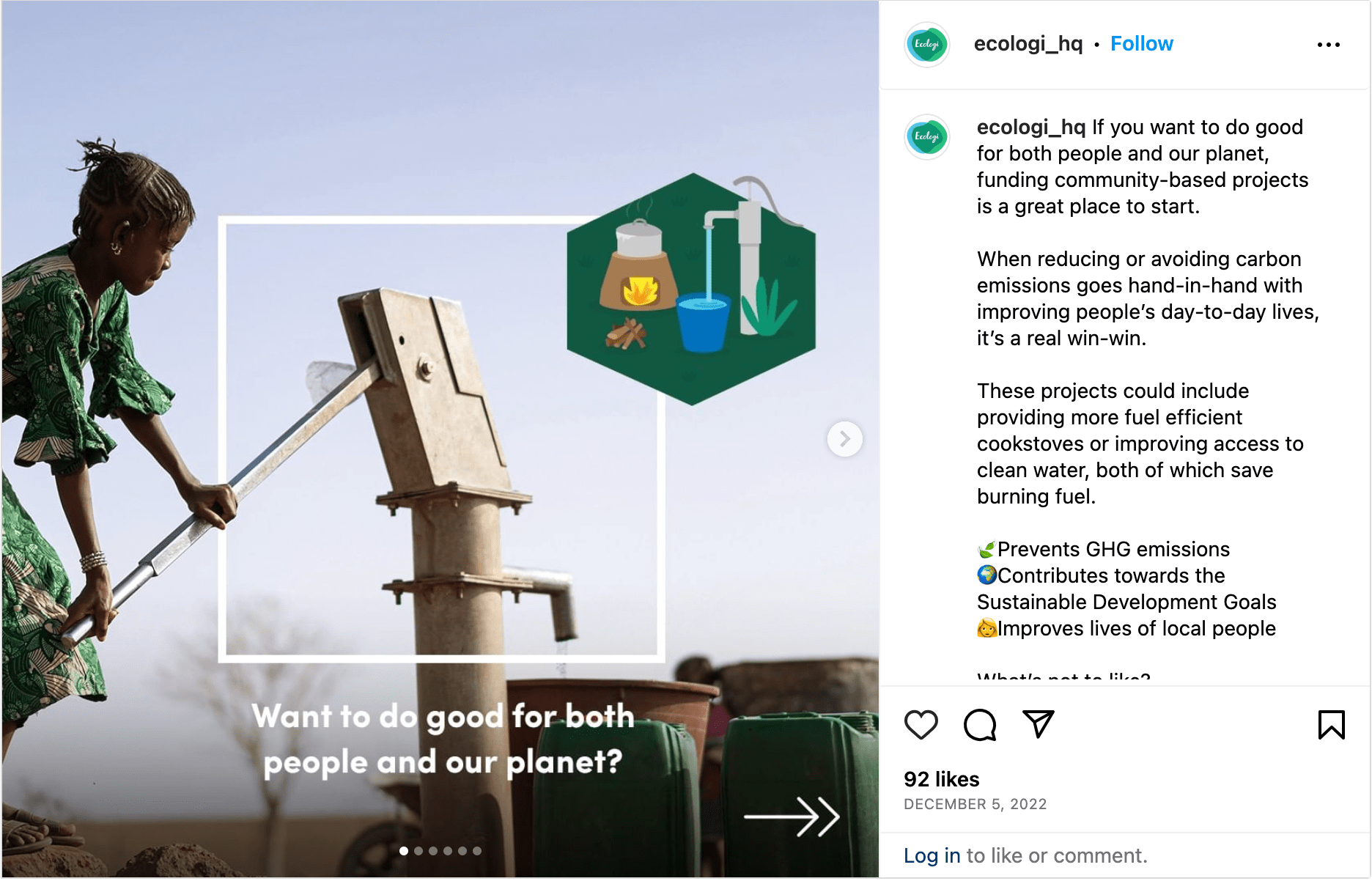Chances are you’ve heard the words “carbon offset” thrown around in relation to our emissions. It may seem like a common enough concept on the surface, but have you ever stopped to consider all that they entail?
In this article, we’ll take a look at the basics of carbon offsetting, some of its pros and cons, and consider examples along the way.
How does carbon offsetting work?
The idea emerged as a solution to help neutralize and reduce greenhouse gas (GHG) emissions during the 1997 Kyoto Protocol.
In its purest form, carbon offsetting revolves around supporting projects that reduce or remove carbon dioxide from the atmosphere, offering individuals and organizations an opportunity to offset their own carbon footprint.
Before diving into the steps of carbon offsetting, there are a few things that should be understood:
- There are two types of carbon markets: voluntary and mandatory.
- Carbon offsetting is generally part of the voluntary carbon market. There is also the mandatory carbon market (or carbon compliance market), where generally carbon credits are transacted.
- Carbon credits are issued by the government, while carbon offsets are issued by organizations with operations in carbon removal (think tree planting, renewable energy investments, land restoration, etc).
- Carbon offsetting makes it easier and more cost-effective for organizations to pursue emission-reducing activities. It’s meant to be equivalent to a company ceasing an emission-causing activity, from a climate change perspective.
- Carbon credits work like this: Governments have been limiting the amount of GHGs companies can emit by placing a cap on them. In order to comply, companies have to reduce their emissions. If a company’s overall emissions are below what’s required by law, it can sell excess credits to other companies that are unable or unwilling to cut emissions to comply.
- One carbon credit or one carbon offset equals one tonne of carbon emissions.
- Carbon offsetting is available for individuals, companies, or any other organizations. Carbon credits are only open to companies and are required by law.
Although there are many moving parts, here is a simplified process of how carbon offsetting works for companies, in theory – if it worked perfectly:
- A company does everything it can to reduce emissions from its business model.
- Only then does a company enter the voluntary carbon market. Corporate emissions are calculated by an offset provider.
- Emissions of carbon-emitting companies can be offset by the purchase of carbon offsets which are issued by organizations that pull CO2 emissions from the air.
- Carbon-neutral certifications can be provided to the purchasers for assurance of their legitimacy.
Now let’s get into the pros and cons of carbon offsetting:
Pro #1: Reduced emissions beyond direct control
One of the key advantages of carbon offsetting is having the ability to counteract emissions beyond an individual or organization’s direct control that might otherwise remain unaddressed. A key component or climate action is the development of clean efficient alternatives, for example, but what happens when the technology is not yet developed or ready for implementation?
Progress takes time. So, carbon offsetting can be used to create opportunities for organizations to contribute to the fight against climate change while better technology is developed for their activities. The aviation industry, which creates about 2% of global carbon emissions, is an example. It’s absolutely best to use alternatives when possible (shoutout to France). But, flight can’t always be avoided. Proper carbon offsetting may be one of the more pragmatic options we have to address fossil fuel emissions as we await the days of renewable-energy powered air-travel.

Pro #2: Climate action driver
Carbon offsetting can serve as a catalyst for climate action by raising awareness and encouraging individuals and businesses to take responsibility for their carbon footprints. It wasn’t so long ago that organizations were allowed to pollute without repercussions or caps. Now, carbon offsetting creates an incentive to track and reduce emissions throughout their supply chains.
By participating in offset programs, people can become more conscious of their environmental impact and be motivated to adopt sustainable practices and technologies in their daily lives or operations.
Pro #3: Support for sustainable development
Carbon offsetting projects often prioritize sustainable development in local communities.
For instance, initiatives focused on renewable energy can bring clean power to underserved regions, improve air quality, create employment opportunities, and foster economic growth. By investing in such projects, carbon offsetting contributes to the United Nations Sustainable Development Goals, promoting social and environmental progress.
Carbon offset programs have made it possible to bring clean drinking water to developing communities and provided safe and efficient cooking equipment to those in need, efforts that would otherwise need to find funding elsewhere.

Pro #4: Financing for clean projects
Offsetting generates financial resources that can be directed towards clean energy, conservation, and innovation. The funds raised from carbon offsetting programs can finance renewable energy infrastructure, promote research and development of green technologies, and support conservation efforts, contributing to a transition to a low-carbon economy.
Projects that at one time would have sounded like science fiction, such as algae fuel production or marine energy generation, are able to continue their work because of investment from issued carbon credits.
Con #1: Greenwashing
And now, we flip the coin.
There is a risk that carbon offsetting can give individuals and organizations the impression that they’re making a larger impact than they are. Or worse, organizations can use carbon offset programs to mislead consumers and make themselves appear as a sustainable choice when they aren’t.
A recent article by the The Guardian explored how more than 90% of rainforest carbon offsets issued by the world’s leading certifier, Verra, were worthless. Companies such as Gucci, Shell, and EasyJet had purchased these offsets and were able to claim carbon neutrality. The investigation found that the projects had no positive effect or were even contributing negatively to the climate crisis.
Had the study not been conducted, Verra’s projects would trundle on unchallenged, organizations would continue to promote their “positive” efforts, and all of that with dubious impact in the background to back it all up.
Con #2: Lack of global standards
This brings us to the next con: the absence of globally recognized standards for carbon offsetting leading to inconsistency and confusion.
Different programs and certifications vary in rigor and transparency, making it a challenge for onlookers, buyers and businesses to navigate the offset market effectively. Establishing robust and internationally accepted guidelines and certifications would enhance credibility (and impact) in the carbon offsetting landscape.
The EU emissions trading system (ETS) is currently the largest international carbon pricing initiative. Other countries such as China, Japan, New Zealand, South Korea, and the United States are testing or implementing their own. Each of these systems have varying regulations, and even vary by region within the countries themselves. This makes it increasingly difficult to compare the efficacy of projects and compare the true efforts of businesses around the globe.
Con #3: Pursuing “additionality”
One challenge for carbon offset projects lies in ensuring the concept of “additionality.” This is essentially the need to prove the additional benefit that a project has towards carbon reductions. It’s crucial to ensure that offset projects genuinely result in additional emissions reductions beyond those that are already created.
For example, hydropower projects often come under fire due to the environmental damage they may cause. One must consider if they still carry additionality after factors such as habitat damage, biodiversity loss, potential community displacement, and methane creation from reservoirs are accounted for.
Beyond those complexities, one must also consider that many impressive-sounding climate projects can be poorly organised, or lacking in forethought. The result being little to no impact.
Con #4: Limited scope and solutions
Carbon offsetting alone cannot solve the climate crisis.
While it’s a valuable tool, it has limitations in scale and long-term impact. In other words, it simply can’t keep up with the emissions or humanitarian demand. To achieve substantial results, more focus is needed on decarbonization, energy efficiency, and systemic changes across industries. Carbon offsetting should be seen as a supplementary approach to be used alongside direct emission reduction efforts rather than a standalone solution.

Not every program is made equal, and neither are the regulations behind them. Some organizations’ carbon offset initiatives are doing great work, and others are greenwashing for their own gain. It will take continued regulation work to make sure that the global carbon market is transparent and truly contributes to a more sustainable future.
For anyone keen to lessen their environmental impact, it can be hard to tell what exactly you’re supporting or to become complacent when we see the beguiling “carbon neutral” label. By supporting certified projects, offsetting can drive emission reductions beyond individual control, promote sustainable development, and provide financial support for clean initiatives. But, only if the certification is reliable.
Overall though, it seems that offsetting will play a supporting role in the fight against climate change, as efforts to reduce or eliminate emissions in the first place move to center stage.
At Akepa, we began working with ClimatePartner in 2021 to calculate our carbon footprint and get involved in climate action projects to mitigate our impact. But we also reduce our emissions as far as we can through initatives like remote work. Over the next year, we’ll be working with ClimatePartner on a more comprehensive decarbonization plan. Read more to know what projects we’ve been supporting, or send us a message to see how we can contribute to the growth of your sustainable organization.



Leave a Reply